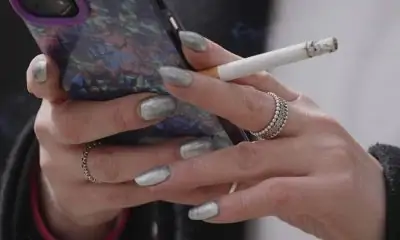“It seems like there are more galleries closing than opening so the opportunities for artists to show their work are diminishing.” — Shane O’Brien of Gallery Jones
Art
City's visual arts district disintegrating, one gallery at a time – Vancouver Sun

Shane O’Brien, co-owner of Gallery Jones located in The Flats.
The gradual disappearance of Vancouver’s visual arts neighbourhood looks like it will pick up steam in 2020.
Once marketed as The Flats, it is an area east of Main from Industrial Avenue to the north to East 7th to the south. At its height, it grew into a mixture of about a dozen non-profit and private art galleries where people could easily walk from one gallery to another and see modern and contemporary works by local and international artists. In 2017, The Flats held its fifth annual summer block party.
But that’s all changed since then. First Catriona Jeffries, arguably one of the top art spaces in the country, closed in 2018 and opened a new location on East Cordova earlier this year. Then Winsor Gallery, after 16 years in three different locations, closed its space in the neighbourhood.
Galleries that remain include private ones such as Elan Fine Art and Macaulay & Co Fine Art and non-profits such as grunt and Burrard Arts Foundation.
By next year, two other top galleries will have to move to make way for the new Broadway Subway extension. A third may also have to move to a new location before the end of 2020.
Related
Gallery Jones has a year to go on its lease at 1-258 East 1st. But with a station on the new subway extension planned by the new Emily Carr University of Art & Design, rents in the area are increasing by as much as 50 to 75 per cent, said Shane O’Brien, co-owner and director.
“That’s not sustainable for our business,” he said. “I’m not sure what’s going to happen.
“It seems like there are more galleries closing than opening so the opportunities for artists to show their work are diminishing.”

The Equinox Gallery.
Francis Georgian /
PNG
The ministry of transportation and highways said construction on the Broadway Subway is expected to start in the fall of 2020. That means demolishing 525 Great Northern Way, the industrial building where Equinox Gallery and Monte Clark Gallery, two of the cities top art galleries, are located.
Andy Sylvester, owner of Equinox Gallery. said he and his agent are looking every day for a new location.
“I’ve looked at, I don’t know, 50 buildings. There is a significant and complicated problem in how art galleries function in respect to legislation at city hall and the taxes and the rent. It’s a very different world for us now compared to when we moved here.”
Equinox, one of the city’s oldest art galleries, was founded in 1972 by Elizabeth Nichol. Equinox moved from South Granville to The Flats in 2012.

Andy Sylvester the owner of Equinox Gallery.
Francis Georgian /
PNG
At 14,000 sq. ft, Equinox has more floor space than any other private art gallery in Vancouver. Sylvester realizes he’s not going to find anything that size at a price he can afford. But he can’t even find anything half that size.
One of the biggest problems he’s facing is the city’s policy of taxing a building on its “highest and best use” which is determined by B.C. Assessment based on zoning and market evidence. If a one story building, for example, is on a site zoned for a 20-storey condo tower, the smaller building can be taxed at the rate of the bigger building.
He found one potential new home but taxes of $147,000 a year made the site uneconomic.
Sylvester said he remembers being inspired the first time he walked into 525 Great Northern Way, the former paint and mechanical shop for Finning International.
“The floor was painted black and it was a rough looking space,” he said. “You could envision possibilities that would inspire people. That’s what I still want.”
Related
Monte Clark, who has owned and operated Monte Clark Gallery for almost 30 years, said while he’s actively looking for a new gallery, he would prefer to put all that energy into promoting his artists.
Art galleries showing challenging contemporary art like his are in a grey area when it comes to zoning.
“Are we retail or are we a warehouse?” Clark asked.
Yes, he said, his business is retail because people come into the gallery to buy art. But a lot of the work his gallery does is with collectors by email and phone calls from people who may come to the gallery itself to see a work.
His gallery has also become a storage space for art works because artists can no longer afford large studios where they once were able to keep their work. It’s also a workplace where art works are framed and shipped to collectors — often on approval.
“We created our own art zone,” he said about The Flats.
“Now it is about to be completely dismantled. You’d think someone at the city would meet with us and say: ‘OK you guys, what can we do?’”
O’Brien of Gallery Jones said he’s “stubbornly holding onto the idea” that galleries and visual artists make valuable contributions to a city.
”I want to make it so that artists can have viable careers where they’re not living below the poverty line, don’t have to move to Vancouver Island or Saskatoon,” he said.
“But that’s becoming increasing difficult day by day.”
Related
Don MacMillan, the owner of South Main Gallery, located on the southern edge of The Flats, said the closure of his gallery at the end of September had nothing to do with the high cost of real estate.
That’s because he owned his ground floor unit at East 6h and Main. His reasons were personal.
When his mother and a few of his friends died, the arrival of his 68th birthday made him think of his own mortality even though he was having “the most fun” he’d ever had in his life putting on exhibitions and working with artists.
“The last year was one of the best financially but not enough to hire a few more people,” MacMillan said.
“Being in business for years, you know what it would take to get it there. I don’t have the same push and energy to do that any longer.”
One thing he said was missing in Vancouver is an association of art galleries. He recognizes that art galleries are protective of their client lists but it might help to deal with shared issues by presenting a united front.
At the end of June, Kimoto Gallery on West 6th just west of Granville closed after more than 70 exhibitions in six years.
Construction of an 11-storey building across the street would have led to a drastic reduction in walk-in business Monday to Friday, said gallerist Katsumi Kimoto.
“It is a tough business and with higher rents and taxes it’s become increasingly more difficult to stay in the established art gallery areas,” he said in an email.
Related
CLICK HERE to report a typo.
Is there more to this story? We’d like to hear from you about this or any other stories you think we should know about. Email vantips@postmedia.com
Art
A misspelled memorial to the Brontë sisters gets its dots back at last

LONDON (AP) — With a few daubs of a paintbrush, the Brontë sisters have got their dots back.
More than eight decades after it was installed, a memorial to the three 19th-century sibling novelists in London’s Westminster Abbey was amended Thursday to restore the diaereses – the two dots over the e in their surname.
The dots — which indicate that the name is pronounced “brontay” rather than “bront” — were omitted when the stone tablet commemorating Charlotte, Emily and Anne was erected in the abbey’s Poets’ Corner in October 1939, just after the outbreak of World War II.
They were restored after Brontë historian Sharon Wright, editor of the Brontë Society Gazette, raised the issue with Dean of Westminster David Hoyle. The abbey asked its stonemason to tap in the dots and its conservator to paint them.
“There’s no paper record for anyone complaining about this or mentioning this, so I just wanted to put it right, really,” Wright said. “These three Yorkshire women deserve their place here, but they also deserve to have their name spelled correctly.”
It’s believed the writers’ Irish father Patrick changed the spelling of his surname from Brunty or Prunty when he went to university in England.
Raised on the wild Yorkshire moors, all three sisters died before they were 40, leaving enduring novels including Charlotte’s “Jane Eyre,” Emily’s “Wuthering Heights” and Anne’s “The Tenant of Wildfell Hall.”
Rebecca Yorke, director of the Brontë Society, welcomed the restoration.
“As the Brontës and their work are loved and respected all over the world, it’s entirely appropriate that their name is spelled correctly on their memorial,” she said.
The Canadian Press. All rights reserved.
Art
Calvin Lucyshyn: Vancouver Island Art Dealer Faces Fraud Charges After Police Seize Millions in Artwork

In a case that has sent shockwaves through the Vancouver Island art community, a local art dealer has been charged with one count of fraud over $5,000. Calvin Lucyshyn, the former operator of the now-closed Winchester Galleries in Oak Bay, faces the charge after police seized hundreds of artworks, valued in the tens of millions of dollars, from various storage sites in the Greater Victoria area.
Alleged Fraud Scheme
Police allege that Lucyshyn had been taking valuable art from members of the public under the guise of appraising or consigning the pieces for sale, only to cut off all communication with the owners. This investigation began in April 2022, when police received a complaint from an individual who had provided four paintings to Lucyshyn, including three works by renowned British Columbia artist Emily Carr, and had not received any updates on their sale.
Further investigation by the Saanich Police Department revealed that this was not an isolated incident. Detectives found other alleged victims who had similar experiences with Winchester Galleries, leading police to execute search warrants at three separate storage locations across Greater Victoria.
Massive Seizure of Artworks
In what has become one of the largest art fraud investigations in recent Canadian history, authorities seized approximately 1,100 pieces of art, including more than 600 pieces from a storage site in Saanich, over 300 in Langford, and more than 100 in Oak Bay. Some of the more valuable pieces, according to police, were estimated to be worth $85,000 each.
Lucyshyn was arrested on April 21, 2022, but was later released from custody. In May 2024, a fraud charge was formally laid against him.
Artwork Returned, but Some Remain Unclaimed
In a statement released on Monday, the Saanich Police Department confirmed that 1,050 of the seized artworks have been returned to their rightful owners. However, several pieces remain unclaimed, and police continue their efforts to track down the owners of these works.
Court Proceedings Ongoing
The criminal charge against Lucyshyn has not yet been tested in court, and he has publicly stated his intention to defend himself against any pending allegations. His next court appearance is scheduled for September 10, 2024.
Impact on the Local Art Community
The news of Lucyshyn’s alleged fraud has deeply affected Vancouver Island’s art community, particularly collectors, galleries, and artists who may have been impacted by the gallery’s operations. With high-value pieces from artists like Emily Carr involved, the case underscores the vulnerabilities that can exist in art transactions.
For many art collectors, the investigation has raised concerns about the potential for fraud in the art world, particularly when it comes to dealing with private galleries and dealers. The seizure of such a vast collection of artworks has also led to questions about the management and oversight of valuable art pieces, as well as the importance of transparency and trust in the industry.
As the case continues to unfold in court, it will likely serve as a cautionary tale for collectors and galleries alike, highlighting the need for due diligence in the sale and appraisal of high-value artworks.
While much of the seized artwork has been returned, the full scale of the alleged fraud is still being unraveled. Lucyshyn’s upcoming court appearances will be closely watched, not only by the legal community but also by the wider art world, as it navigates the fallout from one of Canada’s most significant art fraud cases in recent memory.
Art collectors and individuals who believe they may have been affected by this case are encouraged to contact the Saanich Police Department to inquire about any unclaimed pieces. Additionally, the case serves as a reminder for anyone involved in high-value art transactions to work with reputable dealers and to keep thorough documentation of all transactions.
As with any investment, whether in art or other ventures, it is crucial to be cautious and informed. Art fraud can devastate personal collections and finances, but by taking steps to verify authenticity, provenance, and the reputation of dealers, collectors can help safeguard their valuable pieces.
Art
Ukrainian sells art in Essex while stuck in a warzone – BBC.com
[unable to retrieve full-text content]
Ukrainian sells art in Essex while stuck in a warzone BBC.com

Source link
-

 News20 hours ago
News20 hours agoCanadanewsmedia news October 18, 2024: Testy B.C. election campaign reaches final day
-

 News20 hours ago
News20 hours agoUS to probe Tesla’s ‘Full Self-Driving’ system after pedestrian killed in low visibility conditions
-

 News20 hours ago
News20 hours agoAdvocates urge Ontario to change funding for breast prostheses, ostomy supplies
-

 News20 hours ago
News20 hours agoMore details expected on proposed deal that would see tobacco giants pay billions
-

 News20 hours ago
News20 hours ago‘Kindness’ influencers on TikTok give money to strangers. Why is that controversial?
-

 News20 hours ago
News20 hours agoHousing, health, and plastic straws: Here’s how B.C. politicians are wooing voters
-

 News20 hours ago
News20 hours agoTesty B.C. election campaign sees leaders attacking each other more than policy
-

 News20 hours ago
News20 hours agoRwanda shrugs off ‘sportswashing’ criticism in pursuit of a winning development formula




















